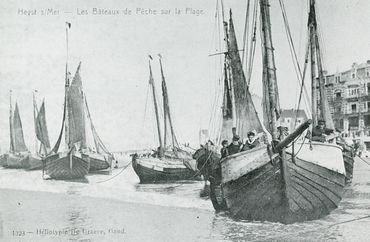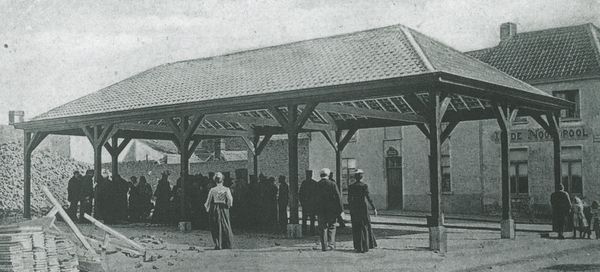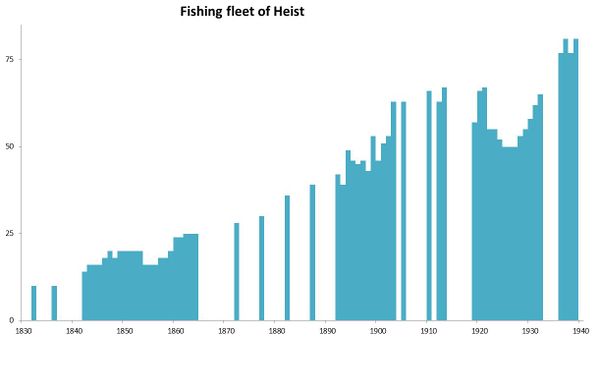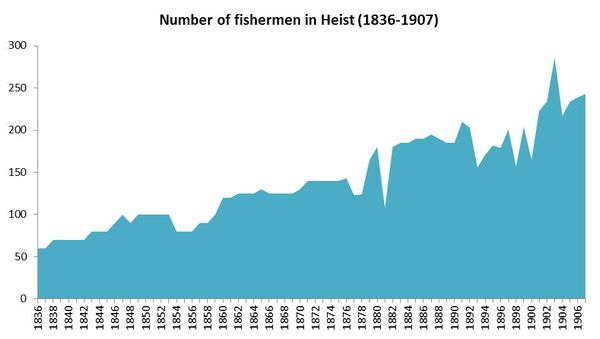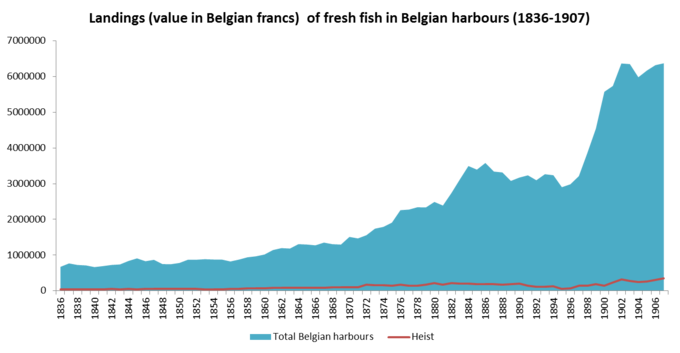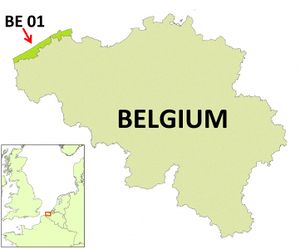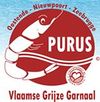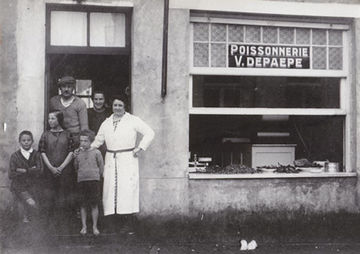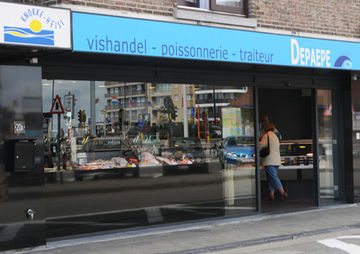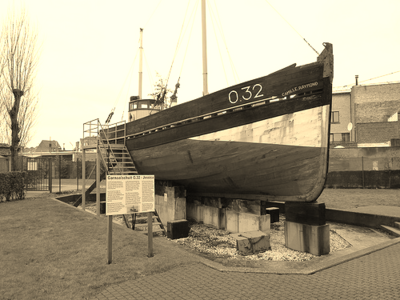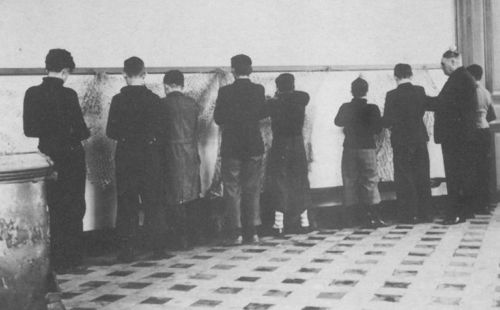Difference between revisions of "Fisheries in Heist"
(→Summary) |
(→Summary) |
||
| Line 123: | Line 123: | ||
|restaurantshotels=[http://www.restaurantbartholomeus.be/Bart-Desmidt-1.html Restaurant Bartholomeus] | |restaurantshotels=[http://www.restaurantbartholomeus.be/Bart-Desmidt-1.html Restaurant Bartholomeus] | ||
|fishselling=[http://www.vishandeldepaepe.be/ Vishandel Depaepe]. It was established in Heist in 1928 by Victor Depaepe and is nowadays managed by a fifth generation of this family. | |fishselling=[http://www.vishandeldepaepe.be/ Vishandel Depaepe]. It was established in Heist in 1928 by Victor Depaepe and is nowadays managed by a fifth generation of this family. | ||
| − | |tourism= | + | |tourism='Vistival’, which fits into the ‘Dag van de Heistse visserij’ (‘'Day of the Heist fisheries’').<br /> |
| − | + | Every year on August 15th, the day of the Assumption of the Virgin Mary into Heaven, the '''procession''' ‘Stella Maris’ moves through the town of Heist in honour of Our Lady, Star of the Sea and recalls the origin of Heist as a fishermen’s village. The procession is followed by the '''Benediction of the Sea''', performed by the chaplain of sea fisheries | |
| − | |||
|museums=[http://www.sincfala.be/sf/ Sincfala], the museum of the Zwin area. | |museums=[http://www.sincfala.be/sf/ Sincfala], the museum of the Zwin area. | ||
|monuments=In 1964, a '''monument''' honoring the fishermen of Heist was erected. It was designed by sculptor André Taeckens and represents a [http://www.knokke-heist.be/pagina/vissersmonument-taeckens fisherman with wife and child].<br /> | |monuments=In 1964, a '''monument''' honoring the fishermen of Heist was erected. It was designed by sculptor André Taeckens and represents a [http://www.knokke-heist.be/pagina/vissersmonument-taeckens fisherman with wife and child].<br /> | ||
Revision as of 08:24, 29 August 2014
Contents
Overview and Background
The Belgian coast is 67 km long and is entirely bordering the province of West-Flanders (region of Flanders, Belgium). The Belgian part of the North Sea is 3,457 km2 (0.5% of the North Sea area), of which more than 1/3 or 1,430 km² are territorial sea within 12 nautical miles distance of the coastline. Belgium currently has 10 coastal municipalities and 4 coastal ports (Nieuwpoort, Oostende, Zeebrugge and Blankenberge), and besides the fish auctions located in Oostende, Zeebrugge and Nieuwpoort where fish is sold according to legal procedures, there are no other dispersed landing points. Although historically the port and auction of Oostende was by far the most important, today the auctions of Zeebrugge (53%) and Oostende (45%) receive the largest share of the landings of Belgian fisheries in Belgian ports.
Belgium has a minor role in the European fisheries context with 0.35% of the total EU production of fish. In 2012, the Belgian commercial sea fishing fleet counted 86 ships, with a total engine capacity of 49,135 kW and gross tonnage of 15,326 GT [1]. 45 vessels are part of the Small Fleet Segment (max 221 kW engine power) of which 2 use passive gear. The remaining 41 vessels belong to the Large Fleet Segment and have an engine power between 221 kW and a maximum of 1,200 kW. This fleet segment represents approximately 80% of the engine power capacity and 77% of the GT of the fleet. While a smaller number use trammel nets (passive gear) and otter trawl, the largest share of the Large Fleet Segment are beam trawl vessels (≥662 kW). The Belgian fleet is highly specialized: more than 68% of the effort(days at sea) and 77% of total landings are achieved by beam trawlers(2010)focusing primarily on flatfish species such as plaice (Pleuronectes platessa) and sole (Solea solea). The results of the reconstruction of the Belgian fleet dynamics since 1830 are presented in Lescrauwaet et al. 2013[2].
The number of days at sea per vessel is fixed at a maximum of 265 per year and in 2011 the entire fleet realized a fishing effort of 15,855 days at sea. In 2011, the Belgian fleet landed a total of 20,138t, of which 16,905t were landed in Belgian ports. Plaice is the most important species in terms of landed weight. The landings of 2011 represented a value of €76.3 million, 14% of which was marketed in foreign ports. Sole generates 47% of the current total value of fisheries in Belgium. The Belgian sea fisheries represent 0.04% of the national Gross Domestic Product [3]. The main fishing grounds in terms of volume of landings in 2010 were in descending order: North Sea South (IVc), Eastern English Channel (VIId), North Sea Central (IVb), Southeast Ireland/Celtic Sea (VIIg) Bristol Channel (VIIf) and Irish Sea (VIIa).
In terms of direct employment, 439 fishers are registered of which approximately 350 are of Belgian nationality. Direct employment in fisheries represent approximately 0.5% of the total employment in the Belgian coastal zone. Another 1040 persons work in the fish processing industry and another 5000 persons in associated trade and services [1]. A historical overview of Belgian sea fisheries is available from [4] and [2].
The Belgian sea fishery sector is rather small compared to that of neighbouring countries in the North Sea and has been gradually losing importance since the Second World War. It is also gradually losing importance relative to the booming tourism industry in the Belgian coastal zone. However fisheries can be an added value to the tourism experience at the coast by developing fisheries-related tourism activities [5].
Port description
Heist (Geographical coordinates: 51°20'N 3°14'E) is situated at the eastern part of the Belgian coast and has a population of about 12.900 people. It is part of the municipality Knokke-Heist, which next to Heist and Knokke also comprises the villages Ramskapelle, Westkapelle and Duinbergen. From the 13th century onwards, Heist became known as a relatively important fishing place, despite the absence of an actual port. Traditionally, the fishing vessels moored on the beach. Similar to those of Blankenberge, the boats of Heist had a flat bottom, which made it easier to land on and depart from the beach [6].During a first period of fishery activity, which lasted till the end of the 16th century, the fleet of Heist took part in the important and prosperous Flemish herring fisheries. Circa 1525, Heist had around 10 herring busses (‘haringbuizen’) and 150 fishermen, on a total number of 450 inhabitants [7]. However, due to the religious wars in the second half of the 16th century, this industry vanished in Heist and during the 17th and the first part of the 18th century no active fishermen were reported in this village. With the help of the Austrian government however, the fishing sector in Heist slowly recovered from the second part of the 18th century on [8].This time around, the village focused on fresh fishery with small boats, close to the shore [7].In 1800, 4 of these vessels were counted in Heist. The fleet subsequently grew steadily over the course of the 19th century and in 1905, 60 boats and 234 fishermen were reported [9] (see also graph 1 and 2).
- Fig. 1 and 2. Part of the Heist fishing fleet, moored on the beach (Dekeyzer, 1969).
In 1901, Heist even got its own fish auction. The construction and inauguration of the port of Zeebrugge in 1906 eventually halted this flourishing period: more and more ships left Heist for Zeebrugge and after only five years, the Heist fish auction lost its purpose [8] [10]. Eventually, all ships from this town relocated to Zeebrugge. As a result, the typical flat bottomed vessels disappeared in favor of faster ships with keels [6].
- Fig. 3. An image of the Heist fish auction, that only existed for a short number of years (Devent, 1989).
Fishing Fleet
As shown on graph 1 and noted above, the fleet of Heist grew subsequently over the course of the 19th century. Fleet data from 1929 onwards are available from the Officieele lijst der visschersvaartuigen documents. In 1940 the last fishing vessels were recorded in Heist. Since then the fishing vessels left Heist and mainly chose Zeebrugge as their home harbor.
Graph 1: Fishing fleet in Heist (Source: 1832-1841: (1866). Rapport de la Commission chargée de faire une enquête sur la situation de la pêche maritime en Belgique. Séance du 17 mai 1866. Chambre des Représentants: Bruxelles. XLII, 75 pp.; 1842-1864: Enquete sur la situation de la peche maritime en belgique instituee par arrete du 20 avril 1865, 1872-1903: ICES Fisheries Statistics = Bulletin Statistique des Pêches Maritimes, 1905: De Zuttere (1909). Enquête sur la pêche maritime en Belgique, 1910: Von Schoen, F. (1912). La pêche maritime de la Belgique, 1928: Officieele lijst der visschersvaartuigen).
Due to the flourishing fishing activities during the 19th century, a lot of people were employed in the fisheries sector in Heist. Graph 2 illustrates the number of fishermen from 1836 until 1907 (De Zuttere, 1909). The number of fishermen grew steadily over the years, together with the increasing number of ships. Heist counted 286 fishermen in 1903.
- Graph 2: Number of fishermen in Heist (1836-1909) (Source: De Zuttere, 1909).
Landings
In Dezuttere, 1909, the annual landings of ‘fresh fish’ were recorded from 1836 till 1907. The category ‘fresh fish’ refers to fish caught by coastal fishing vessels. A further classification by species is unfortunately not available. Heist played a not unimportant part in this type of fishery during the 19th century, but couldn’t hold on to that position after the inauguration of the harbour of Zeebrugge in 1906. The landing figures were written down in the old currency of the Belgian franc.
- Graph 3: Landings (value in Belgian francs) of fresh fish in Heist (red line) (1836-1907) (Source: De Zuttere, 1909).
Governance and Organisations
In Belgium, the FLAG, also called the ‘local group’, ‘Plaatselijke Groep Belgisch Zeevisserijgebied’, is a partnership between socio-economic stakeholders in the fisheries sector, NGOs and public authorities that play a crucial role in the implementation of the proposed development strategy. The lead partner of the Belgian FLAG is the Province of West Flanders. The main focus of the FLAG strategy is to add value to local fisheries products and increase local consumption. Belgian landings represent only 10% of fisheries products consumed in Belgium, leaving the remaining 90% to be met by imports. Therefore there is a considerable potential for discovering and developing local markets. It will also support diversification, innovation, the involvement of women and efforts to promote the sustainable management of the marine environment[11].
- Fig. 6. Belgian FLAG area: West Flanders
Branding
The Flemish brown shrimp is a typical fisheries product in Belgium. In 2006 the Purus label was introduced by a cooperation of ship owners, the cooperative Flemish fisheries organization (Cooperative Vlaamse Visserij Vereniging CVBA) to promote the Flemish unpeeled brown shrimps. The brown shrimps are caught by Belgian fishermen, the fishermen fish no longer than 24 hours and the shrimps are cooked in old Flemish manner (in sea water with salt), there are no additives, preservatives added. This all results in high quality taste. The Purus label also promotes sustainable fishing techniques.
Since 2011, the Flemish Shellfish- and fish cooperation (VSVC) supply, via an exclusive quality label, ‘North Sea Life’, life brown shrimps and swimming crabs to restaurants and wholesalers. Life shrimps allows chefs to determine how they will prepare the shrimps. Life product forms the base of creative and gastronomic possibilities. The same is true for life swimming crabs. In 2013 a minimum of 200 kilo life brown shrimps were landed each day. Prices for life shrimps are on average 30 percent higher than shrimps cooked on board of the shrimp vessel [12].
Fish as Food
Several fish restaurants can be found in Heist and the rest of the municipality of Knokke-Heist. For example, located on the seawall of Heist, you can find Restaurant Bartholomeus, which recently received its second Michelin star. Chef Bart Desmidt was born and raised at the Belgian shore and grew up in a family of fishermen: both his grandfather and his uncle were fishermen. He prefers to work with local ingredients, such as polder products and North sea fish [13].
There are several fish shops located in the municipality of Knokke-Heist. (click here for an overview). A fish shop in Heist with a long history is Vishandel Depaepe. It was established in Heist in 1928 by Victor Depaepe and is nowadays managed by a fifth generation of this family. The fish shop purchases its fish at the fish auction of Zeebrugge. Apart from a wide range of North sea fish, customers can also find lobsters from Canada, Norway or the Oosterschelde (Eastern Scheldt) and oysters from Zeeland and Normandy.
- Fig. 4 and 5. The fish shop ‘Depaepe’, then and now (Vishandel Depaepe).
Tourism/Education
- Heist’s past as a fisheries town is annually commemorated during the ‘Vistival’, which fits into the ‘Dag van de Heistse visserij’ (‘'Day of the Heist fisheries’'). The one-day-festival offers an overview of the past, present and future of the fishing industry and invites the visitor to discover how to live from and with the sea, through a wide range of exhibitions and demonstrations [14].
- Every year on August 15th, the day of the Assumption of the Virgin Mary into Heaven, the procession ‘Stella Maris’ moves through the town of Heist in honour of Our Lady, Star of the Sea and recalls the origin of Heist as a fishermen’s village. The procession is followed by the Benediction of the Sea, performed by the chaplain of sea fisheries [15] [16].
- In 1964, a monument honoring the fishermen of Heist was erected. It was designed by sculptor André Taeckens and represents a fisherman with wife and child. Every year, on the Sunday before the Carnival-festivities in Heist, floral wreaths are deposited at the base of the monument, to commemorate the fishermen who lost their lives at sea [17].
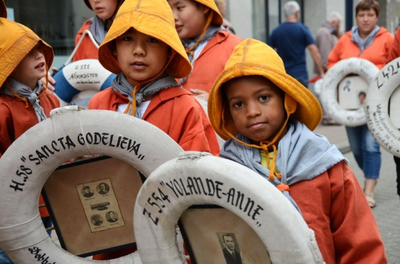
Fig. 8. Image of the procession ‘Stella Maris' (© www.knokke-heist.be) |
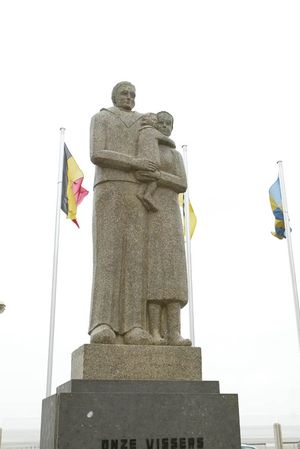
Fig. 9. The fishers monument of Heist (© Sara Hemeleers – www.standbeelden.be) |
- A fishermen’s chapel was built in Heist in 1892 and was renovated in 1992-1994. The altar is devoted to Our Lady, Star of the Sea (Onze-Lieve-Vrouw Ster der Zee or Stella Maris). The chapel is decorated with blue stained glass windows depicting ships and seamen, and votive offerings of life buoys, boats and pictures of fishermen who died at sea [18].
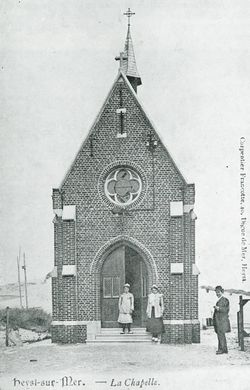
Fig. 10. The fishermen’s chapel of Heist in the olden days, when it was still surrounded by sand and dunes (Dekeyzer, 1969). |
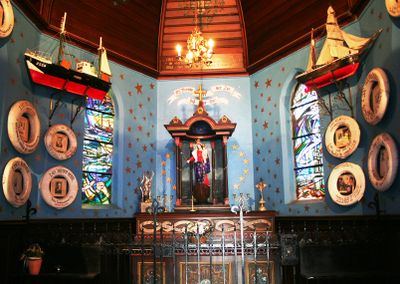
Fig. 11. The interior of the fishermen's chapel of Heist (© Onze kust / VLIZ (Coppieters), 2007). |
- Sincfala, the museum of the Zwin area, is located in Heist and devotes an important part of its space to the town’s history of fisheries. In a specific section of the museum, the tough daily life of young and old fishermen and their families is portrayed. The museum takes a closer look at, amongst other things, their living conditions, their opportunities for amusement in local bars, the evolution of shipbuilding and what life was like aboard a fishing vessel. In the backyard, the ‘O.32 Jessica’, an old wooden shrimp boat from the 1930s, is exhibited [19].
Fig. 12. The ‘Jessica’, an old wooden shrimp boat from the 1930s, which is preserved in the Sincfala museum (© Kneistikrant.be).
In 1904 the ‘Vrije Visserijschool’, the first fisheries school of Heist, opened its doors. Originally, the school only offered theoretical and practical courses on Saturday afternoon and Sunday morning. From 1925 onwards however, it became an evening school for boys aged 13 to 17 years . In 1947, it eventually transformed into a day school. In the same year, another fisheries school appeared in the same town: the ‘Rijksvisserijschool De Golfbreker’. 31 years later, in 1978, both fisheries institutes merged into the ‘Visserijschool van de Vlaamse gemeenschap’, which was later renamed as the ‘Provinciaal Maritiem Instituut’. In 2005, the institute in Heist was shut down and all maritime education was centralized in Ostend [20].
- Fig. 7. Students learn how to mend nets in the ‘Vrije Visserijschool’, circa 1930 (Devent, 1989).
Summary
| Background information | |||
|---|---|---|---|
| Fishing Fleet | Vessel type 1 | ||
| Fishing Fleet | Vessel type 2 | ||
| Fishing Fleet | Vessel type 3 | ||
| Fishing Fleet | Vessels total | ||
| Landings | Total Landings (tonnes) | Demersal (tonnes) | |
| Landings | Total Landings (tonnes) | Pelagic (tonnes) | |
| Landings | Total Landings (tonnes) | Shellfish (tonnes) | |
| Landings | Total Landings (tonnes) | Main species (tonnes) | |
| Landings | Total Landings (tonnes) | All species (tonnes) | |
| Landings | Values | Demersal | |
| Landings | Values | Pelagic | |
| Landings | Values | Shellfish | |
| Landings | Values | All species | |
| Landings | Number of fishermen | Number of fishermen (Regular) | |
| Landings | Number of fishermen | Number of fishermen (Part-time) | |
| Landings | Number of fishermen | Number of fishermen Total | |
| Landings | Major fish species | ||
| Landings | Landing points | ||
| Landings | Location of auctions | ||
| Governance and organisation | Governance | ||
| Governance and organisation | FLAG | West Flanders | |
| Governance and organisation | Location of fishermen's organisations | ||
| Branding | Brand labels | The Purus label promotes the Flemish unpeeled brown shrimps. Via ‘North Sea Life’ label, the Flemish Shellfish- and fish cooperation (VSVC) supply life brown shrimps and swimming crabs to restaurants and wholesalers. | |
| Fish as food | Fish selling | Vishandel Depaepe. It was established in Heist in 1928 by Victor Depaepe and is nowadays managed by a fifth generation of this family. | |
| Fish as food | Fish processing | ||
| Fish as food | Restaurants/hotels | Restaurant Bartholomeus | |
| Tourism & Education | Tourism & Fishing | 'Vistival’, which fits into the ‘Dag van de Heistse visserij’ (‘'Day of the Heist fisheries’'). Every year on August 15th, the day of the Assumption of the Virgin Mary into Heaven, the procession ‘Stella Maris’ moves through the town of Heist in honour of Our Lady, Star of the Sea and recalls the origin of Heist as a fishermen’s village. The procession is followed by the Benediction of the Sea, performed by the chaplain of sea fisheries | |
| Tourism & Education | Festivals | ||
| Tourism & Education | Fishing museums | Sincfala, the museum of the Zwin area. | |
| Tourism & Education | Aquariums | ||
| Tourism & Education | Monuments | In 1964, a monument honoring the fishermen of Heist was erected. It was designed by sculptor André Taeckens and represents a fisherman with wife and child. A fishermen’s chapel was built in Heist in 1892 and was renovated in 1992-1994. | |
| Tourism&Education | Fishing training School | In 1904 the ‘Vrije Visserijschool’, the first fisheries school of Heist, opened its doors. In 2005, the institute in Heist was shut down and all maritime education was centralized in Ostend. | |
References
- ↑ 1.0 1.1 Roegiers, B.; Platteau, J.; Van Bogaert, T.; Van Gijseghem, D.; Bekaert, K.; De Bruyne, S.; Delbare, D.; Depestele, J.; Lescrauwaet, A.-K.; Moreau, K.; Polet, H.; Robbens, J.; Vandamme, S.; Van Hoey, G.; Verschueren, B. (2013). VIRA Visserijrapport 2012 Departement Landbouw en Visserij: Brussel. 98 pp.
- ↑ 2.0 2.1 Lescrauwaet, A.-K. (2013). Belgian fisheries: ten decades, seven seas, forty species: Historical time-series to reconstruct landings, catches, fleet and fishing areas from 1900. PhD Thesis. Ghent University (UGent): Gent. xiii, 242 pp.
- ↑ Anon. (2008). Strategische Milieubeoordeling van het Nationaal Operationeel Plan voor de Belgische visserijsector, 2007 - 2013. ILVO Visserij: Oostende. 103 pp.
- ↑ Lescrauwaet, A.-K.; Debergh, H.; Vincx, M.; Mees, J. (2010). Fishing in the past: Historical data on sea fisheries landings in Belgium. Mar. Policy 34(6): 1279-1289. dx.doi.org/10.1016/j.marpol.2010.05.006
- ↑ Anon. (2011). Europees Visserijfonds (EVF). AS 4: ontwikkelingsstrategie voor het Belgisch kustgebied. Europees Visserijfonds: (s.l.). 33 pp.
- ↑ 6.0 6.1 Larbouillat, J. (1974). De zeevisserij te Heist. Heemkundig Museum Sincfala: Knokke-Heist. 1-80 pp.
- ↑ 7.0 7.1 ‘Evolutie van strand- en kustvisserij’ Sincfala – Museum van de Zwinstreek, consulted on february 19th, 2014.
- ↑ 8.0 8.1 Devent, G. (1989). De Vlaamse zeevisserij. Marc Van de Wiele: Brugge. ISBN 90-6966-061-X. 208 pp.
- ↑ Desnerck, G.; Desnerck, R. (1974). Vlaamse visserij en vissersvaartuigen: 1. De havens. Gaston Desnerck: Oostduinkerke. 256 pp.
- ↑ Hovart, P. (1994). 150 jaar zeevisserijbeheer 1830-1980: een analyse van normatieve bronnen. Mededelingen van het Rijksstation voor Zeevisserij (CLO Gent), 235. Rijksstation voor Zeevisserij: Oostende. 317 pp.
- ↑ FLAG factsheet - Belgium - West Flanders
- ↑ Press release ILVO, 29/05/2013
- ↑ Interview with Bart Desmidt, Vlaanderen Vakantieland 2013, consulted on February 20th 2014.
- ↑ News municipality of Knokke-Heist, Vistival
- ↑ Benediction of the Sea en Procession 'Stella Maris', Knokke-Heist.be)
- ↑ Procession 'Stelle Maris', Landelijk Expertisecentrum voor Cultuur van Alledag
- ↑ Dekeyzer, M. (1969). Heist: van vissersdorp tot badstad. Eddy-Druk: Heist-Duinbergen. 120 pp.
- ↑ De Inventaris van het Bouwkundig Erfgoed, Visserskapel Heist
- ↑ Website Museum Sincfala
- ↑ ‘Visserijonderwijs’, Sincfala – Museum van de Zwinstreek, part of the exhibition Klasgenoten in Heist-aan-zee (2009-2010), consulted on february 19th, 2014
